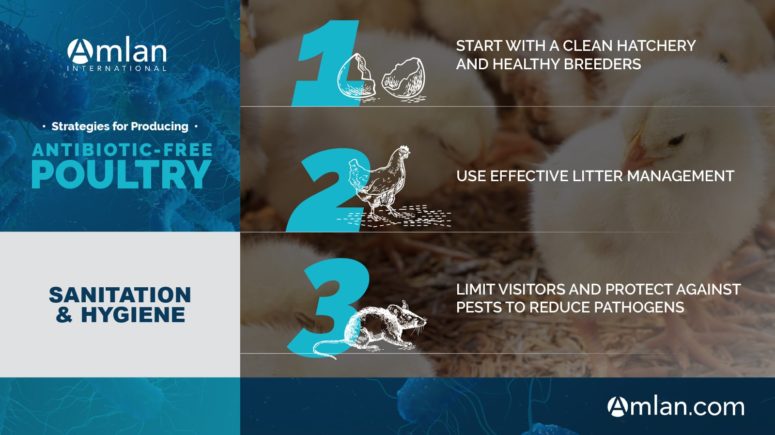All poultry farms should maintain effective house sanitation and biosecurity practices to produce healthy and productive birds, but this is even more important when the goal is antibiotic-free (ABF) production. Here, we take a closer look at what our industry experts consider as best practices for house environment when producing ABF broilers, as part of our series on strategies for producing antibiotic-free poultry.
A Healthy Start to Life
Producing healthy flocks begins at the hatchery. It is important that the chick is provided a clean environment right from the start, and this includes while it is still in the egg. The hatchery should be kept clean, disinfected often and there should be no contamination on the egg pack. If in ovo vaccination is used, sanitary conditions are crucial to keep infection and 7-day mortality rates low. Keeping the chick’s stress low during transport and transition to the farm is also important for a healthy, productive bird.
Starting with a strong, healthy chick is important, as weak chicks are more likely to succumb to pathogens and have higher mortality rates. Once the chicks arrive at the house, they should immediately be provided with high-quality nutrients, which includes fresh, clean water as well as feed. Water quality best practices are discussed in another post that is part of our strategies for producing ABF poultry series.
Another important factor in producing a strong, healthy chick is a healthy breeder. A healthy breeder produces a better egg (e.g., superior shell quality) which means a safer start for the chick. To keep breeders healthy in a ABF system, feed additives can be used instead to ensure peak performance.
Effective Litter Management: Time Consuming but Essential
Litter management is critical to keeping birds healthy and productive and reducing disease challenges. The ideal litter has a depth of 3 to 4 inches and has low moisture and ammonia levels. When choosing an appropriate litter (e.g., pine shavings, rice hulls, hay, wheat straw), it is important to consider how well it absorbs moisture and if it can contaminate feeders easily.
In some cases, litter can be reused if any caked/wet litter is removed first. Wet litter can be prevented by managing water nipples, lines, pressure and height correctly and monitoring for leaks regularly. An effective ventilation system is also important for keeping litter dry, ammonia levels low and birds healthy. We will discuss the importance of air quality in a future ABF best practices post.
Our industry experts recommend allowing 14 days between batches to get the litter dried out. They also recommend windrowing (piling into rows) the litter during this time. While it is time expensive, windrowing heats the litter (it should be at least 130 °F or 54 °C for 3 to 4 days), reducing the pathogen load and infestation of insects such as darkling beetle, while allowing the surrounding floor to dry.
It’s also recommended that once a year the house is cleaned to the ground, disinfected, the floors salted, and dust removed as much as possible. Some producers may notice that the first batch of birds in the house after an annual cleanout does not perform as well, since the beneficial bacteria are also removed when the litter is completely removed.
Biosecurity Is Key
The biggest risk to introducing pathogens and disease to a flock is people, especially those responsible for the flock’s day-to-day management. To avoid infecting the flock, visitors to the farm should be limited and personal protective equipment should always be worn. This can include boots, mask, hair nets, coveralls and gloves and using footbaths between houses. Even though boots worn in the houses should be left at the farm, it is good practice to use disinfectant spray on shoes and floorboards when arriving at and leaving farms. Any shared equipment and the tires of vehicles should also be sprayed with disinfectant when moving between farms. Ideally, equipment that is used often should be purchased for and remain at each farm.
Rodents can also carry pathogens into the house and infect the flock. Even if the house appears sealed, rodents may still find a way in. Insects can also be an issue, particularly for long-lived birds (25 to 65 weeks). Therefore, it is advisable to have a pest control system in place. Wild birds like ducks and geese can also introduce pathogens (e.g., avian influenza) into the flock by contaminating open water sources (e.g., ponds) or through foot traffic.
Managing poultry house environmental conditions and biosecurity takes a lot of time and resources but is essential for keeping flocks healthy and production profitable. Amlan is dedicated to developing next-generation technology to help poultry producers keep birds healthy and maintain productivity for life. Download a helpful, printable guide that summarizes the above best practices here, and check our Education Center for other posts on our ABF production best practices series.

